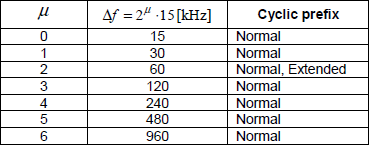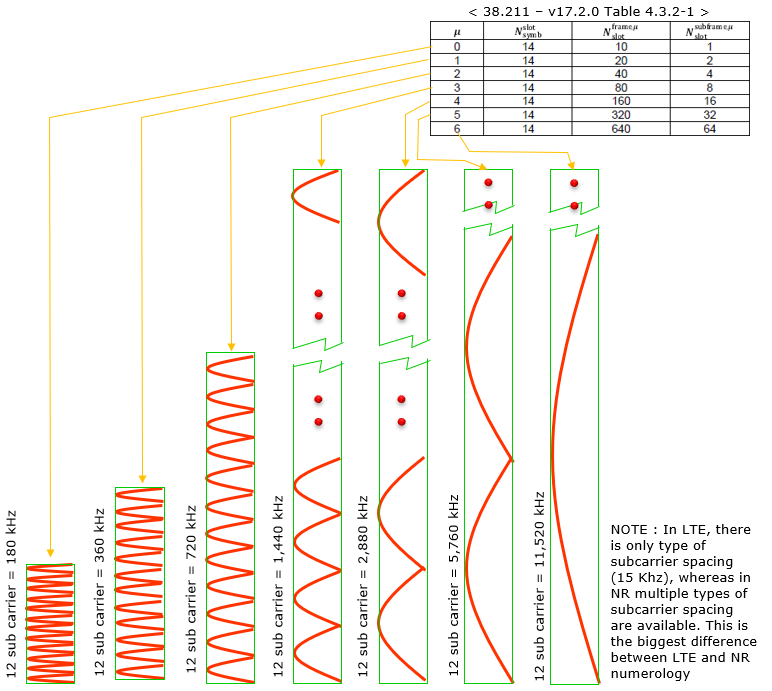|
|
||||||||||||||||||||||||||||||||||||||||||||||||||||||||||||||||||||||||||||||||||||||||||||||||||||
|
Numerology / SCS (Subcarrier Spacing) in DetailNumerology in 5G/NR refers to Sub Carrier Spacing (SCS). As of Release 17, there are 7 types of numberology (SCS 15, 30, 60, 120, 240, 480, 960 Khz). Even though Numerology is one of the most widely discussed item at 3GPP RAN1 meeting before NR Technical Specification is finalized, it sounds very vague to me. I think I understand what it indicates, but I still don't understand the meaning of Numerology in ordinary dictionary can be associated with what it means in NR. Definition of NumerologyThe very simple defination of Numerology based on the usage of the term in 3GPP specification would be 'subcarrier spacing type', also often called as SCS. In LTE, we don't need any specific terminology to indicate the subcarrier spacing since there is only one subcarrier spacing, but in NR there are several different types of subcarrier spacing As of release 17, there are 7 numerology (SCS: Subcarrier Spacing) as shown below. (NOTE : it would be possible to had additional numerology if we support much higher mmWave frequency in future release) < 38.211 v17.2- Table 4.2-1: Supported transmission numerologies >
To help you understand the meaning of each numerology more intuitively I tried to visualize the table as follows. (NOTE: Numberology 5 was defined in an early specification, but removed from the specification.)
Numerology and Supported ChannelsNot every numerology can be used for every physical channel and signals. That is, there is a specific numerologies that are used only for a certain type of physical channels even though majority of the numerologies can be used any type of physical channels. Following table shows which numerologies can be used for which physical channels. < 38.300-Table 5.1-1: Supported transmission numerologies and additional info.>
Numerology in RRC messageNumerology selection is not a static. Different numerology (Subcarrier Spacing) can be used in various different situation and purpose. The subcarrier spacing for different situation and purpose is defined in various places in RRC messages as follows.
Why different Numerologies ?Now you have some important questions on NR Numerology design. You might have these questions even before you went through all the details described above. The question that I had when I first heard of this kind of multiple numerology (basically multiple subcarrier spacing) was 'WHY we need this kind of multiple numerologies ?'. One thing for sure is that it is not for making your life difficult as an engineer. Then, what would be other (more technical) reason ? More technical (practical reason) is
Can you be more specific ?
UE CapabilityFeatureSetDownlinkPerCC ::= SEQUENCE { supportedSubcarrierSpacingDL SubcarrierSpacing, supportedBandwidthDL SupportedBandwidth, channelBW-90mhz ENUMERATED {supported} OPTIONAL, maxNumberMIMO-LayersPDSCH MIMO-LayersDL OPTIONAL, supportedModulationOrderDL ModulationOrder OPTIONAL } supportedSubcarrierSpacingDL : Defines the supported sub-carrier spacing for DL by the UE indicating the UE supports simultaeous reception with same or different numerologies in CA. Note the UE shall support all mandated sub-carrier spacing for FR1/FR2. Same numerology for intraband NR CA including both continuous and non-continuous is mandatory with capability in both FR1 and FR2. Two mixed numerologies between FR1 band(s) and FR2 band(s) in DL are mandatory with capability if UE supports inter-band NR CA including both FR1 band(s) and FR2 band(s). Optional for other cases. RRC ConfigurationFollowings are the RRC configuration that specifies numerology (subcarrier spacing). I would just put a couple of examples of RRC configurations without much detailed explanation. Just taking a look at the example would be self explanatory. The RRC message snippet shown here is from Amarisoft Callbox log. SA
{ message c1: systemInformationBlockType1: { cellSelectionInfo { ... }, cellAccessRelatedInfo { ... }, connEstFailureControl { ... }, servingCellConfigCommon { downlinkConfigCommon { frequencyBandList { { freqBandIndicatorNR 78 } }, offsetToPointA 24, scs-SpecificCarrierList { { offsetToCarrier 0, carrierBandwidth 51 } } }, genericParameters { locationAndBandwidth 13750, }, ... }, uplinkConfigCommon { scs-SpecificCarrierList { { offsetToCarrier 0, subcarrierSpacing kHz30, carrierBandwidth 51 } }, p-Max 10 }, genericParameters { locationAndBandwidth 13750, }, rach-ConfigCommon setup: { rach-ConfigGeneric { ... }, ... restrictedSetConfig unrestrictedSet }, ... }, ssb-PositionsInBurst { inOneGroup '80'H }, ssb-PeriodicityServingCell ms20, tdd-UL-DL-ConfigurationCommon { pattern1 { ... } }, ss-PBCH-BlockPower -28 }, ...
: This part may come in many different variations. For example, some gNB would configure this in RrcSetup or RrcReconfiguration if it want to configures only one BWP. Some gNB would configure this in RrcReconfigration instead of RrcSetup. Some gNB would configure multiples of this configuration (maximum up to 4 BWPs). { message c1: rrcSetup: { rrc-TransactionIdentifier 0, criticalExtensions rrcSetup: { radioBearerConfig { ... }, masterCellGroup { ... }, mac-CellGroupConfig { ... }, physicalCellGroupConfig { ... }, spCellConfig { spCellConfigDedicated { pdcch-Config setup: { ... }, pdsch-Config setup: { ... }, { bwp-Id 1, bwp-Common { genericParameters { locationAndBandwidth 28875, }, pdcch-ConfigCommon setup: { ... }, pdsch-ConfigCommon setup: { ... } }, bwp-Dedicated { pdcch-Config setup: { ... }, pdsch-Config setup: { ... } } }, uplinkConfig { pucch-Config setup: { ...
}, pusch-Config setup: { ... }, srs-Config setup: { ... } }, { bwp-Id 1, bwp-Common { genericParameters { locationAndBandwidth 28875, }, pusch-ConfigCommon setup: { ... }, pucch-ConfigCommon setup: { ... } }, bwp-Dedicated{ pucch-Config setup: { ... }, pusch-Config setup: { ... }, srs-Config setup: { ... } } } } }, firstActiveUplinkBWP-Id0, pusch-ServingCellConfig setup: { } }, NSA
{ message c1: rrcConnectionReconfiguration: { rrc-TransactionIdentifier 0, criticalExtensions c1: rrcConnectionReconfiguration-r8: { ... }, nonCriticalExtension { nonCriticalExtension { nonCriticalExtension { nonCriticalExtension { nonCriticalExtension { nonCriticalExtension { nonCriticalExtension { nonCriticalExtension { nr-Config-r15 setup: { endc-ReleaseAndAdd-r15 FALSE, nr-SecondaryCellGroupConfig-r15 { rrc-TransactionIdentifier 0, criticalExtensions rrcReconfiguration: { secondaryCellGroup { cellGroupId 1, rlc-BearerToAddModList { { ... } }, mac-CellGroupConfig { ... }, physicalCellGroupConfig { pdsch-HARQ-ACK-Codebook dynamic }, spCellConfig { servCellIndex 1, reconfigurationWithSync { spCellConfigCommon { physCellId 500, downlinkConfigCommon { absoluteFrequencySSB 632256, frequencyBandList { 78 }, absoluteFrequencyPointA 632016, scs-SpecificCarrierList { { offsetToCarrier 0, carrierBandwidth 51 } } }, genericParameters { locationAndBandwidth 13750, }, pdcch-ConfigCommon setup: { ... }, pdsch-ConfigCommon setup: { ... } } }, uplinkConfigCommon { scs-SpecificCarrierList { { offsetToCarrier 0, s carrierBandwidth 51 } } }, genericParameters { locationAndBandwidth 13750, }, rach-ConfigCommon setup: { rach-ConfigGeneric { ... }, ... msg1-SubcarrierSpacing kHz30, ... }, pusch-ConfigCommon setup: { pusch-TimeDomainAllocationList { ... }, pucch-ConfigCommon setup: { ... } }, dummy ms500 }, ssb-PositionsInBurst mediumBitmap: '80'H, ssb-periodicityServingCell ms20, dmrs-TypeA-Position pos2, ssbSubcarrierSpacing kHz30, tdd-UL-DL-ConfigurationCommon { referenceSubcarrierSpacing kHz30, pattern1 { ... } }, ss-PBCH-BlockPower -28 }, newUE-Identity 17921, t304 ms1000 }, rlf-TimersAndConstants setup: { ... }, spCellConfigDedicated { initialDownlinkBWP { pdcch-Config setup: { ... }, pdsch-Config setup: { ... }, radioLinkMonitoringConfig setup: { ... }, firstActiveDownlinkBWP-Id 0, uplinkConfig { initialUplinkBWP { pucch-Config setup: { ... }, pusch-Config setup: { ... }, srs-Config setup: { ... } }, firstActiveUplinkBWP-Id 0, pusch-ServingCellConfig setup: { } }, pdcch-ServingCellConfig setup: { }, pdsch-ServingCellConfig setup: { ... }, ... } } } } }, ...
Reference[1] 3GPP R1-166225. 3GPP TSG RAN WG1 Meeting #86 - Considerations on numerology for support of flexible guard lengths [2] 3GPP R1-166346. 3GPP TSG RAN WG1 Meeting #86 - Forward compatibility consideration for NR frame structure [3] 3GPP R1-166360. 3GPP TSG RAN WG1 Meeting #86 - URLLC numerology and frame structure design [4] 3GPP R1-166363. 3GPP TSG RAN WG1 Meeting #86 - Scaled Numerology Control Design for NR [5] 3GPP R1-166364 . 3GPP TSG RAN WG1 Meeting #86 - NR numerology scaling and alignment [6] 3GPP R1-166471. 3GPP TSG RAN WG1 Meeting #86 - Discussion of NR Numerology [7] 3GPP R1-166490. 3GPP TSG RAN WG1 Meeting #86 - Numerology impact on power efficiency for mMTC [8] 3GPP R1-166637. 3GPP TSG RAN WG1 Meeting #86 - Discussion on numerology multiplexing [9] 3GPP R1-166676. 3GPP TSG RAN WG1 Meeting #86 - TDD frame structure with mixed numerology [10] 3GPP R1-166747. 3GPP TSG RAN WG1 Meeting #86 - Evaluation results of OFDM-based waveform in DL and UL single numerology case [11] 3GPP R1-166748. 3GPP TSG RAN WG1 Meeting #86 - Evaluation results of OFDM-based waveform in DL and UL mixed numerology case [12] 3GPP R1-166749. 3GPP TSG RAN WG1 Meeting #86 - Evaluation results of OFDM-based waveform in UL single numerology and asynchronous case [13] 3GPP R1-166753. 3GPP TSG RAN WG1 Meeting #86 - Discussion on symbol alignment across scaled numerology [14] 3GPP R1-166754. 3GPP TSG RAN WG1 Meeting #86 - Discussion on numerology support [15] 3GPP R1-166795. 3GPP TSG RAN WG1 Meeting #86 - Discussion on numerology aspects of NR synchronization signal [16] 3GPP R1-166878. 3GPP TSG RAN WG1 Meeting #86 - Discussion on alignment for different numerology multiplexing [17] 3GPP R1-166879. 3GPP TSG RAN WG1 Meeting #86 - Further evaluation results on different numerology [18] 3GPP R1-166939. 3GPP TSG RAN WG1 Meeting #86 - Numerology evaluation results for high speed scenario [19] 3GPP R1-166940. 3GPP TSG RAN WG1 Meeting #86 - Discussion on numerology multiplexing in NR [20] 3GPP R1-166941. 3GPP TSG RAN WG1 Meeting #86 - On design of mixed numerology in a NR carrier [21] 3GPP R1-167004. 3GPP TSG RAN WG1 Meeting #86 - Discussion on numerology [22] 3GPP R1-167034. 3GPP TSG RAN WG1 Meeting #86 - On PA impact to in mixed numerology with narrow band allocation [23] 3GPP R1-167035. 3GPP TSG RAN WG1 Meeting #86 - On PA impact to in mixed numerology with wide band allocation [24] 3GPP R1-167040. 3GPP TSG RAN WG1 Meeting #86 - On scalable numerology [25] 3GPP R1-167106. 3GPP TSG RAN WG1 Meeting #86 - Phase Noise Measurement/Modeling and LLS for High Frequency Numerology [26] 3GPP R1- 167107. 3GPP TSG RAN WG1 Meeting #86 - Discussion and Evaluation on Numerology Design for High Speed Train Scenario [27] 3GPP R1-167218. 3GPP TSG RAN WG1 Meeting #86 - Numerology and Frame Structure for NR-Unlicensed [28] 3GPP R1-167260. 3GPP TSG RAN WG1 Meeting #86 - Resource block and guard band arrangement supporting mixed numerology [29] 3GPP R1-167261. 3GPP TSG RAN WG1 Meeting #86 - On resource block grouping and multi-cell coordination aspects for mixed numerology support [30] 3GPP R1-167394. 3GPP TSG RAN WG1 Meeting #86 - Views on NR numerology [31] 3GPP R1-167527. 3GPP TSG RAN WG1 Meeting #86 - Discussion on NR Numerology [32] 3GPP R1-167564. 3GPP TSG RAN WG1 Meeting #86 - Impact of numerology on the non-CP based waveforms [33] NR Wide Bandwidth Operations by Jeongho Jeon, Intel Corporation
|
||||||||||||||||||||||||||||||||||||||||||||||||||||||||||||||||||||||||||||||||||||||||||||||||||||

